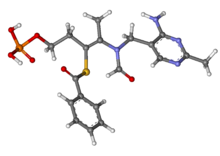Benfotiamine
 | |
 | |
| Clinical data | |
|---|---|
| Trade names | Milgamma |
| Other names | S-Benzoylthiamine O-monophosphate |
| AHFS/Drugs.com | International Drug Names |
| Routes of administration | Oral |
| ATC code | |
| Legal status | |
| Legal status |
|
| Identifiers | |
| |
JSmol) | |
| |
| |
| | |
Benfotiamine (
Uses
Benfotiamine is primarily marketed as an over-the-counter drug to treat diabetic polyneuropathy.[3] A 2021 review described two clinical trials with positive results for diabetic polyneuropathy and concluded that more research is needed.[4]
As of 2017, benfotiamine was marketed as a
Adverse effects
There is little published data on adverse effects. In one study of a combination of benfotiamine, pyridoxine, and cyanocobalamin, around 8% of people taking the drug experienced nausea, dizziness, stomach ache and weight gain.[6]
Pharmacology
Benfotiamine is dephosphorylated to S-benzoylthiamine by ecto-alkaline phosphatases present in the intestinal mucosa, and is then hydrolyzed to thiamine by thioesterases in the liver.[7] Benfotiamine is more bioavailable than thiamine salts,[8] providing higher levels of thiamine in muscle, brain, liver, and kidney.[6]
Benfotiamine mainly acts on peripheral tissues through an increase in transketolase activity.[7][6][9]
Chemistry
Benfotiamine is a lipid derivative of thiamine, specifically a synthetic S-acyl
Research
Benfotiamine has been studied in laboratory models of
Administration of benfotiamine may increase intracellular levels of
See also
References
- S2CID 10384617.
- PMID 34063830.
- ISBN 9780813804286.
- ^ PMID 34040901.
- ^ a b "Benfotiamine International brands". Drugs.com. Retrieved 14 March 2017.
- ^ a b c Panel on Food Additives and Nutrient Sources added to Food (2008). "Scientific Opinion: Benfotiamine, thiamine monophosphate chloride and thiamine pyrophosphate chloride, as sources of vitamin B1 added for nutritional purposes to food supplements" (PDF). The EFSA Journal. 864: 1–31.
- ^ PMID 23066179.
- PMID 1776825.
- ^ Yamazaki M (1968). "Studies on the absorption of S-benzoylthiamine O-monophosphate : (I) Metabolism in tissue homogenates". Vitamins. 38 (1): 12–20.
- ^ PMID 20188835.
- PMID 22982063.
